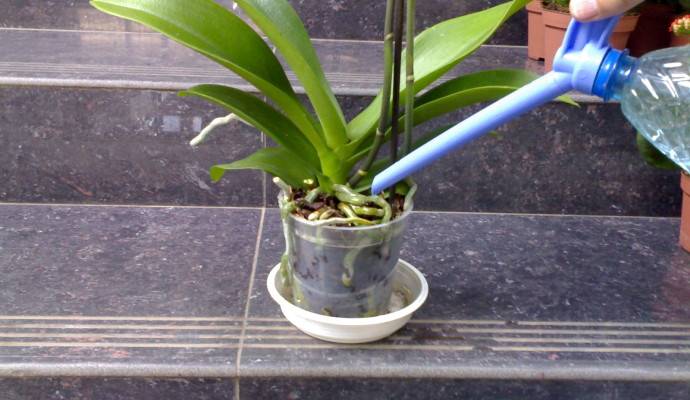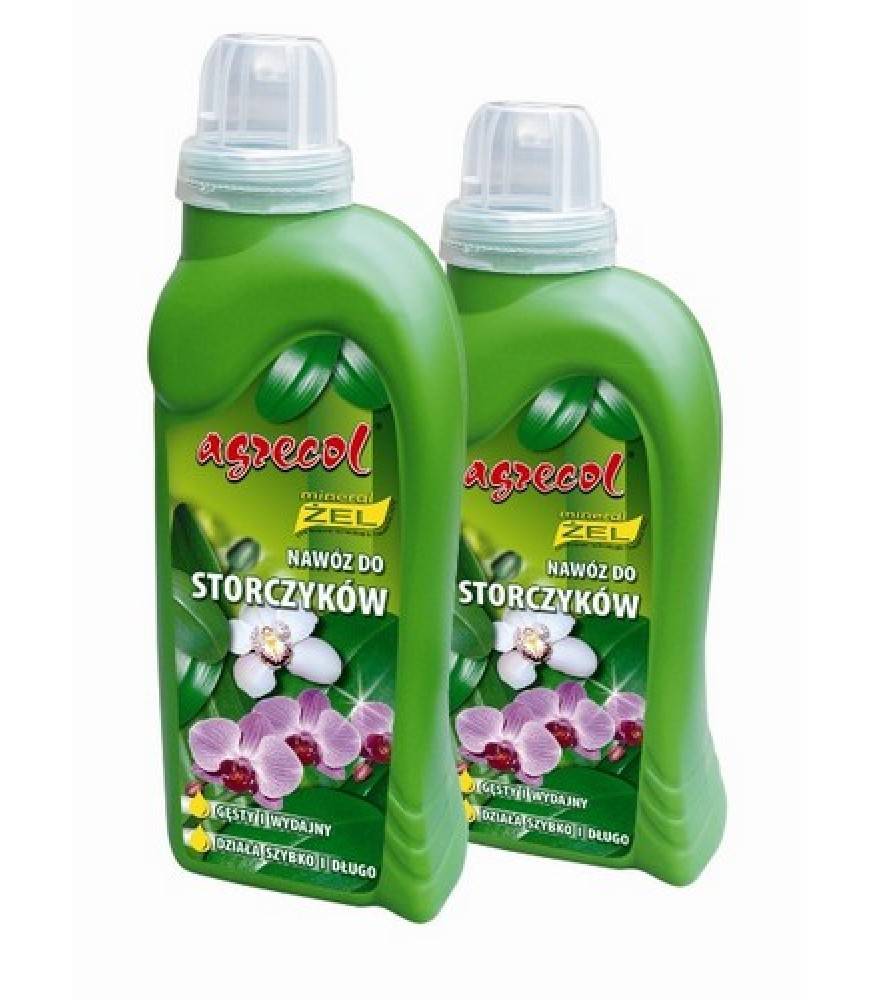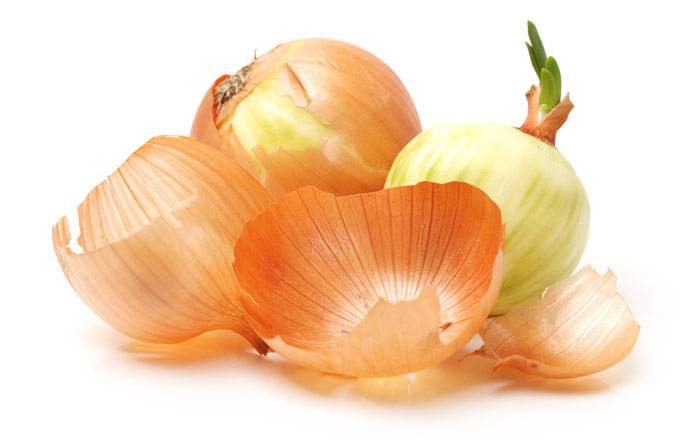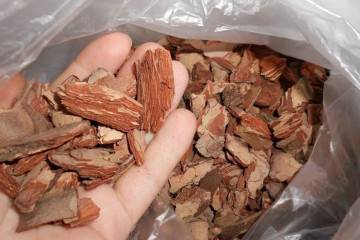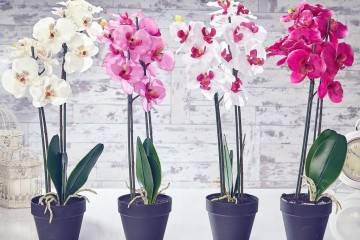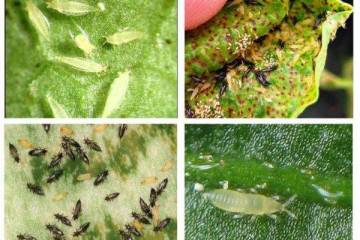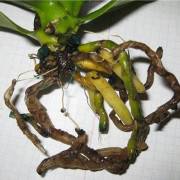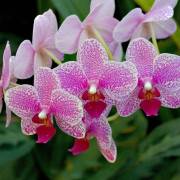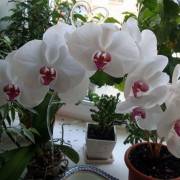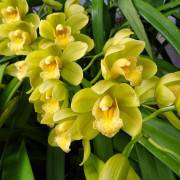What fertilizer is needed for orchids, how to apply
Content:
The orchid is an exquisite and very finicky flower. Feeding the plant with nutrients is required at home. Phalaenopsis is planted in prepared pine bark soil, depriving it of the most important trace elements. In its natural environment, the orchid feeds on rain, dew and fog. To keep the stems and flowers healthy, you need to periodically use orchid fertilizer.
What elements does an orchid need
Before choosing a top dressing for a flower, you need to figure out what nutrients it needs:
- nitrogen. Allows you to grow greens faster due to the acceleration of the process of photosynthesis. Without this element, the stem begins to break, the foliage falls off, the growth rate of the plant decreases;
- potassium. The substance contributes to the more rapid development of flower buds. The immunity of the orchid will gradually strengthen due to the increased carbohydrate metabolism. With a lack of potassium, the inflorescences are small and fragile;
- phosphorus. The chemical element helps to strengthen the root system of the plant, activates the flowering process. Its lack negatively affects the development of the orchid;
- boron and magnesium. These two substances ensure the complete assimilation of nitrogen, phosphorus and potassium. With a lack of elements, the buds will dry out even before opening, the vegetation will slow down and the flowering time will decrease;
- sulfur and iron. If the flower does not receive these substances, then the process of photosynthesis is completely disrupted. Chlorosis forms, the leaves begin to fall off, and the plant turns yellow.
Other useful components are also part of the feeding of orchids, but the main ones are potassium, phosphorus and nitrogen. Depending on the problem that has arisen, you can change the ratio of these substances.
General rules for fertilization
There are two main types of feeding - root and foliar. Features of each type:
- root. Orchid feed is used only for healthy plants. First, you need to moisten the soil with water, after which the drug purchased in advance should be diluted. All proportions are indicated in the instructions. The procedure is carried out at room temperature. A pot with an orchid is placed in a container with fertilizer for 20 minutes, the flower can be watered on top with this solution. After this time, the flowerpot must be removed, it is better to wait until the excess liquid drains. Gardeners recommend feeding in the morning, when the plant absorbs all the useful components as much as possible;
- foliar. This type is used in the presence of diseases that affect the root of the plant, and chlorosis during active growth. Fertilize better in the morning to avoid the active sun hitting the flower. The prepared solution must be sprayed on the foliage on both sides and the visible part of the rhizome. The drug should not get on the buds and inflorescences, but if this has already happened, then the plant should be dried.
Fertilizers and feeding for growth
There are more than 30 thousand types of orchids. Some unique plants require a specific nutrient mix.Below we consider what useful fertilizers can be purchased for the most popular species - phalaenopsis. How to feed an orchid:
- Bona Forte. The concentrated preparation in liquid form is highly effective and low in cost. The solution contains nitrogen, phosphorus, potassium and iron, boron, molybdenum, cobalt, zinc, manganese, copper. All components are presented in a chelated form. Additionally, the dressing contains vitamins B, C and PP. Succinic acid is used as a natural growth accelerator;
- Greenworld. The product is designed specifically for blue or other phalaenopsis flowers, often used as a fertilizer;
- Uniflor-Buton, Ketira-Lux. Versatile and inexpensive preparations that are used for orchids and other houseplants;
- "Hesi". The composition of the preparation is adapted to the needs of the flower. Contains vitamins, micro- and macroelements, flowering and growth enhancers, amino acids, plant enzymes;
- Agrecol. Fertilizer accelerates the development and growth of the plant, the flowers acquire a brighter color. Agricola for Orchids is sold in the form of a gel, allowing it to be easily dissolved in water and dispensed;
- "Dr. Foley". The preparation is suitable for foliar feeding. Contains acids, vitamins and a complex of essential microelements. Great for irrigating the green part of the plant;
- Pokon. Fertilizer for orchids "Pocon" Dutch production is highly efficient. The product is made based on the structural features and flowering of orchids;
- Brexil Combi and Fasco. A complex of micronutrients necessary for beautiful and healthy flowers. It is recommended to spray the flower FROM a spray bottle every three weeks. The composition contains vitamins, potassium, phosphorus, nitrogen.
Some growers know how to fertilize an orchid at home. But this method of feeding orchids, as folk remedies, is difficult to dose in comparison with purchased preparations from the store.
What and how often to feed for flowering
Fertilizers must meet several criteria:
- acidity level is 5-7 pH;
- contains components to prevent salt deposits and chelated elements;
- small concentration of substances in comparison with feeding for other plants;
- contain vitamins and amino acids that help to assimilate useful components and strengthen the flower's immune system.
After buying a plant, the question arises of how to feed a new orchid at home, and how often to do it. The main thing here is not to overdo it. The solutions are not used during the rest period, in the presence of an illness or if less than a month has passed since the transplant.
When a second leaf appears on the stem, it is necessary to apply top dressing, which will help form a healthy plant. During active growth, fertilizer is applied every 2 weeks. In the spring, the procedure is carried out twice a month. The dormant period in winter becomes a break. When a new leaf or children appear, they return to fertilizer again.
Fertilization errors and their consequences
Flower owners often start feeding the orchid right after the purchase. But they do not take into account her appearance and the nutrients she needs. In what cases it is impossible to fertilize a plant so that it does not die:
- it is forbidden to transplant and feed the orchid immediately after purchase in the store. The substrate does not need to be changed for the next 2-3 years, even if the roots do not completely fit in the pot;
- in the presence of flowers on the stems, fertilizer can provoke their rapid death, including the buds. Plants receive full care and abundant watering in greenhouses before they reach store shelves;
- feeding is not applied to sick, weakened and recently transplanted orchids.To strengthen them, preparations are intended for growth and recovery.
Folk fertilization methods
At home, improvised means are equally popular when caring for an orchid. Here are several ways to prepare top dressing:
- banana peel. The fruit contains many nutrients for flower growth. The peel of one banana needs to be dried, cut into small pieces, pour 1 liter of warm water and set aside for 48 hours. Before use, the solution is diluted with water in a ratio of 1: 2 and filtered;
- glucose. Fertilizer helps plants that have damaged root systems due to lack of watering. In 1000 ml of warm water, you need to dissolve 1 tablet of glucose and 1 teaspoon of sugar. The solution is used for wiping leaves and compresses, but not for irrigation. This will prevent the sweetness from getting on the bases of the leaves;
- fern root. For this method, a regular fern will do. The crushed plant should be mixed with the bark in the same ratio. With a lack of roots, a decoction is made from it, which is diluted with water until a light brown tint is formed;
- decoction of onion peel. The solution is rich in vitamins and minerals. Remove the husk from a medium-sized onion, boil it for 10 minutes. and set aside. When the broth takes on a dark brown hue, it must be diluted to a whitish color and watered with flowerpots. For phalaenopsis, this is a complete top dressing. The product is prepared before use.
Regardless of the type of home fertilizer chosen, it is worth adhering to the following rules:
- to avoid burns, the solution is applied to the wet root system;
- water is used at room temperature, separated;
- the product is diluted in a small ratio.
An orchid is a beautiful and expensive flower that is suitable as a gift for a dear person. When buying into your home, you should take care of proper care, transplantation and feeding. A high-quality fertilizer will help the plant to bloom with large and beautiful inflorescences on elastic stems.
